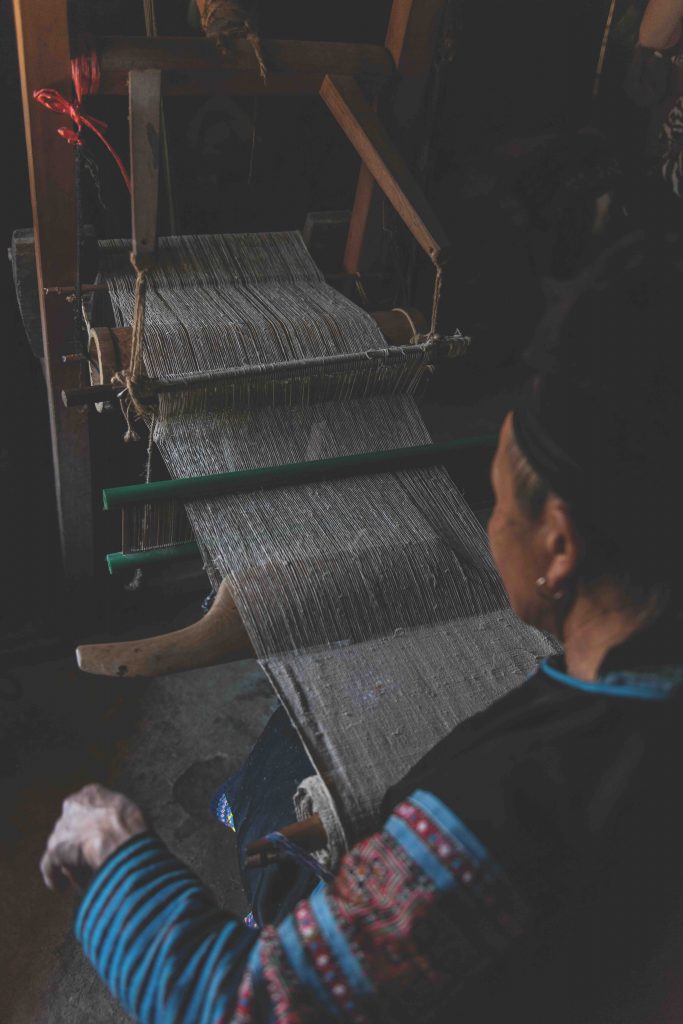Story VU THAO
Photos JULIE VOLA, BENJAMIN REICH
The traditional indigo dyeing methods of the highland regions and the use of fabric scraps from H’Mong traditional costumes are minimalist and “greening” approaches in indigenous fashion.

Living in harmony with nature
The H’Mong people are, first and foremost, outstanding farmers with a particularly rich repository of folk knowledge. In Vietnam, the H’Mong often reside in remote, mountainous areas with rugged terrain and harsh climates. Their agricultural and forestry practices depend heavily on the cycles of rain and sunshine. To manage and adapt to nature, the H’Mong have invented irrigation and cultivation techniques, with terraced fields perhaps the most vivid testament to their farming culture. Symbiotic cultivation is another way they maximize natural resources – raising livestock alongside crops, growing rice while raising fish or practicing crop rotation and intercropping.
The H’Mong possess a high degree of self-sufficiency in production and handicrafts. Their traditional costumes are made entirely from natural materials such as cotton, hemp and silk. They are known for having a long-standing tradition of weaving linen, also known as hemp fabric, which is highly valued among eco-friendly materials for its antibacterial, anti-mold properties, biodegradability and remarkable durability. Hemp plants are pest-resistant, require little water, can improve soil quality and are especially effective at absorbing emissions and converting biomass.
Indigo-colored footprints
Indigo dyeing plays a crucial role in coloring H’Mong attire. Indigo blue dominates the entire costume and serves as the perfect backdrop for other decorative techniques such as embroidery, beading, pom-poms, applique, patchwork, batik and fabric polishing. The H’Mong grow indigo plants in moist garden plots or upland fields. Many H’Mong groups take advantage of old forests, stream banks and valleys to cultivate indigo or let it grow wild. The most common indigo variety in H’Mong communities is the broad-leafed “cham Meo”, scientifically known as Strobilanthes cusia, also called “Assam indigo” or “rain bell indigo.”
Indigo plants are edible and widely used as medicine in East and Southeast Asia. Indigo leaves are brewed as tea and used to heal wounds, while indigo pigment is used in painting, decoration and even tattooing. Naturally dyed indigo fabric is antibacterial and highly durable; H’Mong indigo-dyed garments can last for decades, even up to a hundred years.

The H’Mong’s indigo extraction process, similar to that of many other ethnic minorities, involves fermentation, aeration with lime and filtration. Traditional indigo dyeing was done in wooden barrels or ceramic jars, but nowadays, plastic containers are often used. Their method of fermenting the dye vat is entirely organic, using natural indigo extract and a mixture of herbal water available locally, including aromatic leaves, lemongrass and even corn or rice wine. Maintaining a healthy fermentation culture in the dye vat is an art that requires skill and patience. The H’Mong indigo dyeing technique mainly involves repeatedly dipping the fabric, a labor-intensive process. To achieve a deep blue shade, artisans must dye the fabric for an entire month.
Zero-waste attire
The H’Mong ethnic group consists of various branches – White H’Mong, Black H’Mong, Blue H’Mong, Red H’Mong, and Flower H’Mong – distinguished by the colors and features of their costumes. Each branch has its own unique traditional attire. A typical outfit includes: headscarf, hat, bib, blouse, jacket, skirt, trousers, leg wraps, bag and jewelry.
The H’Mong’s approach to cutting fabric is virtually waste-free, not discarding even a single scrap. Before cutting a new outfit, they carefully calculate the required amount of fabric. The standard width of H’Mong fabric is quite narrow, only 35 to 40 centimeters. As a result, the garment structure is not complicated; all pieces are cut in straight lines and sewn together. The H’Mong use fabric manipulation techniques to alter the appearance and feel of the material. Through folding, pleating, attaching, and patching, they transform flat fabric into three-dimensional forms or enhance visual effects through unique textures and shapes, creating movement on the body. An outfit may consist of more than a dozen parts, yet none are superfluous.
Each H’Mong costume is a statement. Their lifestyle – zero-waste, nature-based – permeates every fold, every stitch, every shade of indigo. In an era when fast fashion depletes resources, the “Blue Indigo Footprints” of the H’Mong – a footprint of living in harmony with nature – stands out as a cultural value worth learning from. It is not only a heritage, but also a sustainable future for humanity.










